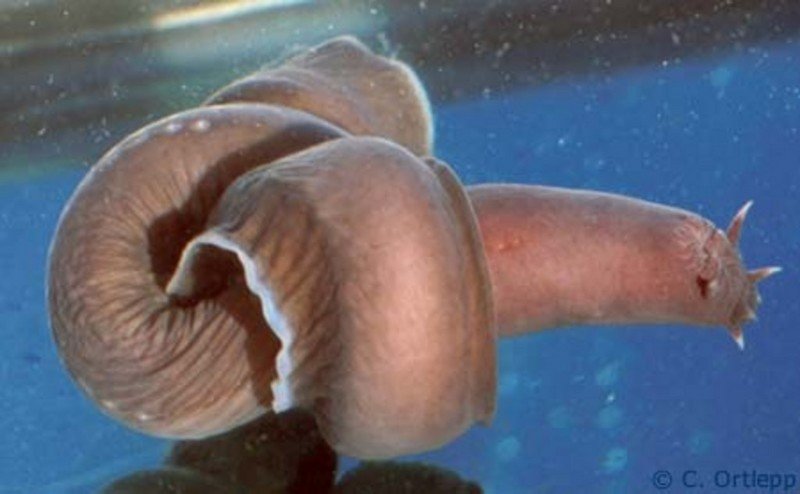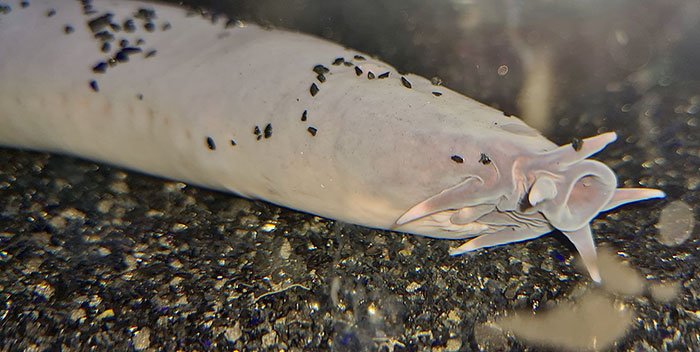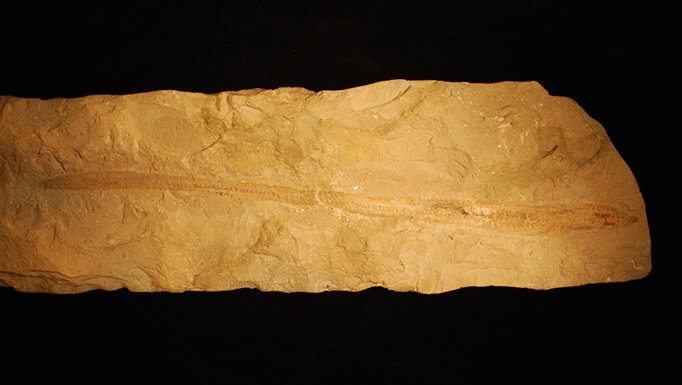Slippery and Slimy Hagfish!
Peter Southwood, CC BY-SA 4.0, via Wikimedia Commons
Imagine all the different ways things have to avoid being eaten. Some plants have developed really bitter tasting chemicals so that they won’t be as appetizing. Some insects blend in with leaves and twigs so that they won’t be recognized by lizards and birds. And some creatures just make themselves, really, really gross so that nothing will want to eat them.
A hagfish is shaped like an eel, but eels have backbones and jaws, and a hagfish has neither, which places it in the class Agnatha, which contains about 100 species of fish without jaws. The hagfish also has no eyes! Instead, it finds its way around using eyespots that can detect light, barbels (fleshy whiskers around its mouth), and a very sensitive sense of smell.
What a hagfish has in abundance is slime.
What the hagfish has in abundance is slime, which it produces when attacked or stressed. They use the slime to avoid being eaten themselves and to drive other fish away from their meals. The hagfish carry the components for slime in their bodies, which mix with water when released, allowing the hagfish to create up to 400 times their own volume in slime. Hagfish live deep in the ocean and are mainly scavengers, but they can go months without a meal, absorbing nutrients directly from the water through their skin.
You probably wouldn’t look at a hagfish and think it would make a tasty meal, and even less so after you see the sheer amount of slime it produces. But if it can be eaten, humans somewhere will eat it, and hagfish is considered a delicacy in Korea. Hagfish skin is also used to make eel leather, which is waterproof. The slime is being considered for use in everything from contact lenses, to military defense, to clothing! People have even tried making tofu using it.
What function would the hagfish have had in God’s original “very good” creation? Even though creatures classified by the Bible as “living beings” would not have died before the fall, there are lots of creatures in the ocean that aren’t “living beings,” and there might have been many more before the global flood wiped out a large portion of ocean species. The hagfish is well-designed to deal with the waste that would otherwise accumulate in the bottom of the ocean.
Footnotes
- Hannah Waters, “14 Fun Facts About Hagfish,” Smithsonian Magazine, October 17, 2012, https://www.smithsonianmag.com/science-nature/14-fun-facts-about-hagfish-77165589/.
- Emily Osterloff, “Hagfishes: How Much Slime Can a Slime Eel Make,” Natural History Museum, accessed November 1, 2023, https://www.nhm.ac.uk/discover/how-much-slime-can-a-hagfish-make.html.
- Osterloff, “Hagfishes: How Much Slime.”
- Lukas Böni, “Gelation of Soy Milk with Hagfish Exudate Creates a Flocculated and Fibrous Emulsion—and Particle Gel,” PLOS ONE 11, no. 1 (January 2016): https://www.ncbi.nlm.nih.gov/pmc/articles/PMC4726539/.
- © 2025 Answers in Genesis
- Privacy Policy
- Contact
- About



